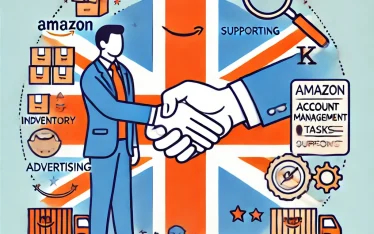TL;DR
- Amazon PPC helps drive quick sales by targeting high-intent keywords and optimizing ad campaigns for better conversions.
- Amazon DSP boosts brand awareness and retargets shoppers who viewed or interacted with your products.
- External traffic from social media, influencers, and email marketing improves rankings and sales.
- Retargeting with DSP helps recover lost sales by engaging shoppers who didn’t complete their purchase.
- Social media ads and influencer partnerships drive new customers to your Amazon store.
- A well-rounded strategy with PPC, DSP, and external traffic ensures sustained growth and higher ROI.
Growing an Amazon business is no longer just about listing optimization and good reviews. With increasing competition, sellers need a solid strategy that combines Amazon PPC, DSP, and external traffic. Each of these plays a unique role in attracting customers, increasing conversions, and building brand awareness. When used together, they create a powerful system that drives sustainable growth.
In this blog, we will break down how PPC, DSP, and external traffic work, their benefits, and how you can integrate them into your marketing strategy for better results.
Use PPC to drive immediate sales
Amazon pay per click advertising management is one of the fastest ways to boost visibility and sales. By strategically bidding on keywords and optimizing ad performance, you can drive immediate conversions and outperform competitors. Here’s how to make Amazon PPC work for your business.
Keyword targeting and bid strategies
Amazon PPC campaigns rely on effective keyword targeting. Choosing the right keywords ensures your ads appear in relevant searches, leading to higher conversion rates. Focus on:
- Exact match keywords – Best for targeting high-intent shoppers who are ready to buy. These keywords ensure your ad appears only for specific search terms.
- Phrase match keywords – Allow for slight variations of your target keyword, giving your ads a bit more reach while maintaining relevance.
- Broad match keywords – Help discover new search terms but require close monitoring to prevent irrelevant clicks.
- Branded keywords – Protect your brand by bidding on your product or brand name to ensure competitors don’t take your traffic.
- Competitor keywords – Bidding on competitor brand names can help you attract potential buyers looking for similar products.
Amazon offers three main PPC ad types:
- Sponsored Products – Promote individual product listings and appear in search results and product detail pages.
- Sponsored Brands – Feature multiple products under your brand logo, useful for increasing brand awareness.
- Sponsored Display – Show ads to shoppers who have viewed your products, helping with retargeting.
Choosing the right bid strategy is also key. You can use:
- Fixed bids – Your bid stays constant without Amazon adjusting it.
- Dynamic bids – down only – Amazon lowers your bid when a conversion is unlikely.
- Dynamic bids – up and down – Amazon raises or lowers your bid based on the likelihood of conversion.
Testing different keyword types and bid strategies will help optimize your campaigns for the best return on ad spend (ROAS).
Optimizing ad creatives and product listings
Even the best PPC strategy won’t work if your product listings aren’t optimized. When running Amazon PPC ads, ensure that your product pages are designed to convert visitors into buyers.
Key elements to optimize:
- Title – Include high-traffic keywords while keeping it readable.
- Images – Use high-quality, zoomable images and lifestyle shots to enhance appeal.
- Bullet points – Highlight key product features and benefits concisely.
- A+ Content – If eligible, use enhanced brand content to improve engagement.
- Reviews and ratings – More positive reviews increase trust and conversion rates.
Your ad creative, especially for Sponsored Brands and Sponsored Display ads, should be visually appealing and convey product benefits.
Tracking and refining campaigns
To get the most out of Amazon PPC, regular monitoring and optimization are essential. Focus on key performance metrics:
- Click-through rate (CTR) – A low CTR may indicate poor ad copy or irrelevant targeting.
- Conversion rate (CVR) – This helps measure how effectively your listing converts visitors into buyers.
- Advertising Cost of Sales (ACoS) – Lower ACoS means better profitability.
- Return on Ad Spend (ROAS) – Higher ROAS indicates better ad efficiency.
Regularly analyze your search term report to find profitable keywords and negative keywords (terms that bring unqualified traffic). Adjust bids based on performance, shift budget to high-converting ads, and test different strategies to maximize results.
Invest in DSP for brand awareness and retargeting
Amazon’s Demand-Side Platform (DSP) is a powerful advertising tool that goes beyond traditional PPC campaigns. Unlike PPC, which primarily focuses on capturing high-intent shoppers through search ads, DSP allows brands to create awareness, retarget potential buyers, and engage with a broader audience. By strategically investing in DSP, brands can strengthen their presence, boost conversions, and build long-term customer loyalty.
What makes DSP different from PPC?
While PPC ads are shown based on search queries, Amazon DSP uses programmatic advertising to serve ads across Amazon-owned properties (like IMDb and Fire TV) and third-party websites. This means you can reach potential customers outside of Amazon, even before they actively start searching for your product.
DSP is particularly useful for:
- Brand awareness – Introduce your brand to new audiences.
- Retargeting – Re-engage shoppers who have interacted with your brand but haven’t converted yet.
- Lookalike audiences – Target people with similar shopping behaviors to your existing customers.
- Competitor conquesting – Show ads to customers who viewed or purchased from competing brands.
Building brand awareness with DSP
If you’re launching a new product or entering a competitive market, DSP can help establish your brand presence. Some of the best strategies for brand awareness include:
- Audience-based targeting – Use demographic data, purchase history, and behavioral insights to target the right audience.
- Video ads and rich media – Use engaging video creatives and interactive ads to increase brand recall.
- Cross-platform visibility – Display your ads on Amazon, third-party sites, mobile apps, and streaming services to increase reach.
Brand awareness campaigns don’t always drive immediate conversions but create long-term value by familiarizing shoppers with your brand. Over time, this leads to higher organic traffic and better results in future PPC campaigns.
Retargeting with DSP: Converting high-intent shoppers
One of the biggest advantages of Amazon DSP is the ability to retarget shoppers who have already shown interest in your products. These include:
- Shoppers who viewed your product but didn’t buy – Remind them of your product with engaging ads and special offers.
- Customers who added to cart but didn’t complete checkout – Encourage them to finalize their purchase with a limited-time discount.
- Past buyers of similar products – Promote complementary products to encourage repeat purchases.
Retargeting ads work best when they highlight customer pain points, showcase social proof (like ratings and reviews), and include a strong call-to-action.
Measuring success and optimizing DSP campaigns
Unlike PPC, which provides instant data on clicks and conversions, DSP campaigns require a broader approach to measurement. Key performance indicators (KPIs) to track include:
- Impressions and reach – Measures how many people saw your ad.
- View-through rate (VTR) – Tracks how many users saw your ad and later visited your product page.
- Click-through rate (CTR) – Indicates engagement with your ads.
- Return on ad spend (ROAS) – Helps determine campaign profitability.
By analyzing these metrics, you can refine audience targeting, adjust ad creatives, and allocate budgets more effectively.
Drive growth with external traffic
Relying solely on Amazon’s internal traffic can limit your brand’s growth potential. External traffic—traffic from sources outside Amazon—can significantly boost your product’s visibility, improve rankings, and drive more conversions. By strategically leveraging external sources like social media ads, influencers, email marketing, and SEO, you can create a powerful sales funnel that brings in new customers and strengthens your brand.
Why external traffic matters for Amazon growth
Amazon rewards sellers who bring traffic from outside platforms. When your product gets purchases from external sources, Amazon’s algorithm sees it as a sign of demand and increases its ranking in search results. This leads to:
- Higher organic rankings – More external traffic can improve your product’s position on Amazon search pages.
- Increased brand control – External traffic allows you to interact with customers beyond Amazon’s ecosystem.
- Better customer retention – You can build long-term relationships with customers through retargeting and email marketing.
Using social media ads and influencers
Social media is one of the most effective ways to drive external traffic to your Amazon listings. Platforms like Facebook, Instagram, TikTok, and Pinterest allow brands to target highly specific audiences based on interests, behaviors, and demographics.
Best practices for social media ads:
- Run conversion-focused ads – Use direct response ads with a clear call-to-action to drive traffic to your Amazon listing.
- Utilize video content – Short-form videos showcasing product benefits perform well on Instagram Reels and TikTok.
- Test different audiences – Experiment with different targeting options to find the best-performing segments.
Influencers can also play a key role in driving external traffic. Partnering with influencers in your niche helps you reach a highly engaged audience and build trust. Consider:
- Amazon influencers – Many influencers have Amazon storefronts and can promote your product through affiliate links.
- Micro-influencers – Smaller influencers (10k-100k followers) often have higher engagement and can drive more targeted traffic.
- User-generated content (UGC) – Encourage influencers and customers to create authentic content that showcases your product in real-life use.
Leveraging email marketing and SEO
Unlike Amazon PPC, email marketing allows you to build a direct relationship with your customers. If you have an existing customer list or are capturing emails through your website, you can drive consistent traffic to your Amazon listings.
Email marketing strategies:
- New product launches – Notify past customers about new arrivals.
- Exclusive discounts – Offer special promotions to encourage repeat purchases.
- Abandoned cart reminders – If you sell on Shopify or another platform, you can remind customers to complete their purchases on Amazon.
SEO (search engine optimization) is another powerful tool for external traffic. A well-optimized blog or website can attract organic visitors who are actively searching for products like yours. Some effective strategies include:
- Writing blog posts around relevant keywords – Example: “Best clip-on magnifying lamps for embroidery” with a direct Amazon link.
- Optimizing YouTube videos – Product review and tutorial videos with Amazon links in the description can drive high-intent traffic.
- Leveraging backlinks – Getting links from other websites to your product pages can improve rankings in Google searches.
Running promotions and affiliate campaigns
Amazon’s Brand Referral Bonus allows sellers to earn a bonus on sales generated from external traffic. This means you can earn additional revenue when bringing shoppers from outside sources.
Affiliate marketing is another effective way to boost sales. Amazon Associates (Amazon’s affiliate program) allows bloggers, YouTubers, and influencers to promote your product in exchange for a commission. Consider:
- Partnering with niche bloggers – Have them include your product in gift guides or product roundups.
- Leveraging deal sites and forums – Submitting your product to websites like Slickdeals or Reddit communities can drive high-intent buyers.
Final thoughts
Mastering PPC, DSP, and external traffic can significantly accelerate your brand’s growth on Amazon. A well-rounded strategy that includes targeted advertising, retargeting campaigns, and off-Amazon promotions helps improve visibility, drive conversions, and build long-term customer loyalty. However, optimizing these channels requires expertise, continuous testing, and data-driven decision-making.
This is where Amazon consultants can make a difference. By leveraging their insights, brands can refine their ad strategies, maximize ROI, and stay ahead of the competition.








